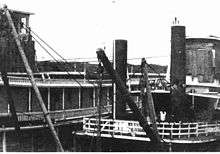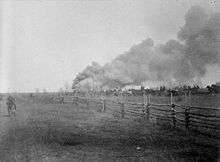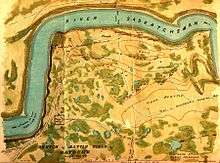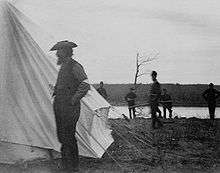Battle of Batoche
The Battle of Batoche was the decisive battle of the North-West Rebellion, which pitted the Canadian authorities against a force of First Nations and Métis people. Fought from May 9 to 12, 1885, at the ad hoc Provisional Government of Saskatchewan capital of Batoche, the greater numbers and superior firepower of General Frederick Middleton's force could not be successfully countered by the Métis, as had happened at the earlier Battle of Fish Creek, and the town was eventually captured. The defeat of the Métis led to the surrender of Louis Riel on May 15 and the collapse of the Provisional Government. Poundmaker surrendered on May 26. Cree fighters and families under Big Bear held out the longest, fighting off Canadian troops pursuing them in the Battle of Frenchman's Butte and Battle of Loon Lake, and, gradually dwindling in number, staying on the move until Big Bear eventually turned himself in to the North-West Mounted Police at Fort Carlton in early July.
| Battle of Batoche | |||||||
|---|---|---|---|---|---|---|---|
| Part of the North-West Rebellion | |||||||
 Contemporary lithograph of the Battle of Batoche | |||||||
| |||||||
| Belligerents | |||||||
| Provisional Government of Saskatchewan (Métis) |
| ||||||
| Commanders and leaders | |||||||
|
Gabriel Dumont Louis Riel |
Frederick Middleton Bowen van Straubenzee | ||||||
| Strength | |||||||
| 250 (Métis) | 916 regulars and militia | ||||||
| Casualties and losses | |||||||
|
16 dead[1][2][3] 30 wounded[1][2] |
8 dead[1] 46 wounded[1] | ||||||
Early advances and the crippling of the Northcote

Conscious of the numerous reverses that had been suffered by government forces in previous clashes with the rebels (see the battles of Duck Lake, Fish Creek, and Cut Knife), Middleton approached Batoche with caution, reaching Gabriel's Crossing on 7 May and advancing within eight miles (13 km) of the town the following day.[4] Middleton's plan rested on an encirclement strategy: as his main contingent advanced directly against Métis defensive lines, the steamboat Northcote, carrying some of Middleton's troops, would steam past the distracted defenders and unload fifty men at the rear of the town, effectively closing the pincer.
However, due to the difficulty of the terrain and Middleton's penchant for prudence, his force lagged behind schedule, and when the Northcote appeared adjacent to the town on 9 May it was spotted by Métis who had not yet come under artillery fire. Their small arms fire did little damage to the armoured ship, but they lowered Batoche's ferry cable, into which the Northcote steamed unsuspectingly, slicing off its masts and smokestacks. Crippled, the ship drifted harmlessly down the South Saskatchewan River and out of the battle.[4][5]
Battle
Mission Ridge (9 May)
Ignorant of the Northcote's fate, Middleton approached the church at Mission Ridge on the morning of 9 May in order to bring his plan into effect. Some Métis in two houses south of the church began firing at Boulton's Scouts (irregular Canadian cavalry), but artillery was brought up to shell the houses, one of which caught fire. The Métis sharpshooters fled toward the settlement.[6] The troops advanced toward the church. As they approached the church and nearby rectory, they saw some people near those buildings whom they took to be the enemy. Second Lieutenant Arthur L. Howard, a Gatling gun expert on leave from the Connecticut National Guard, fired his Gatling gun at the rectory. Then a white flag was unfurled, Howard's firing stopped, and several priests, nuns, women and children came across the lines.[7] Finding the mission occupied only by civilians, Middleton brought his artillery out onto the ridge and began shelling the town.

The soldiers began advancing past the church, and got about half a kilometre before they came under heavy fire from both sides of the trail. The militia immediately took cover. Their enemies, hidden in well-constructed rifle pits, were invisible. One trooper later wrote: "[The militia was] down some distance apart from each other, firing at nothing, making guess shots and hearing the rebel bullets zip all round you, and the everlasting clack as the bullets struck the trees."[6]
The now-dismounted irregular militia cavalry, Boulton's and French's Scouts, were deployed on the right. The 10th Royal Grenadiers, militia infantry from Toronto, were in the centre, with the 90th Winnipeg Rifles militia, and Howard and his Gatling on the left, to protect the artillery. The infantry of the Midland Battalion, militia from eastern Ontario, were kept in reserve near the church, which was now being used as a Canadian field hospital. A very dangerous situation developed when a group of Métis rushed the artillery. Only Howard's directing a heavy stream of Gatling fire at the attackers prevented a disaster. From these few minutes the frustrated soldiers got the only clear view of the Métis fighters that they were to have until the final moments of the battle, three days later.
After the attack was repulsed, the artillery was pulled back a couple of hundred meters, and the infantry and dismounted Scouts followed suit. The Métis then redeployed their men to try to outflank the militia, and heavy fighting ensued. After noon, the artillery was ordered forward again, and it began fruitlessly bombarding the invisible Métis rifle pits. The gunners were under heavy fire, in a very unsafe position. The Midlanders, who had been brought forward from the church, wanted to charge their unseen enemies, but were ordered not to by Middleton.[6]
Throughout, the Gatling gun was used to good effect, providing covering fire for the withdrawal of cannon that had come under sniper fire, and dispersing another attempt by Gabriel Dumont to capture the guns.[8]

Canadian advances saw less success but were carefully conducted, keeping casualties to a minimum. A Métis attempt to surround the Canadian lines failed when the brushfires meant to screen the sortie failed to spread. At the end of the day, both sides held their positions at Mission Ridge. But Middleton, shaken by the fierce resistance, ordered the Canadian soldiers to retire to a "zareba," a hastily improvised fortification about a mile from the Métis entrenchments, where the troops retired to sleep behind their network of improvised barricades.[4][5][7]
Probing attacks (10 May to 11 May)
On 10 May, Middleton established heavily defended gunpits and conducted a devastating, day-long shelling of the town. Attempted advances, however, were turned back by Métis fire, and no ground was gained. The next day, Middleton gauged the strength of the defenders by dispatching a contingent of men north along the enemy's flank while simultaneously conducting a general advance along the front. Having redirected a portion of their strength to hold the northward flank, the Métis lacked the manpower to oppose the Canadian thrust, ceding ground with little resistance. Canadian soldiers ventured as far as the Batoche cemetery before turning back. Satisfied with his enemies' weakness, Middleton retired to sleep and contended to take the town in the morning.[4][5]
Storming of Batoche (12 May)
By 12 May, Métis defences were in poor shape. Of the original defenders, three-quarters had either been wounded by artillery fire or were scattered and divided in the many clashes with the Canadians on the outskirts of the town. Those that still held their positions were fatigued and desperately short of ammunition. They resorted to hunting in the underbrush for bullets fired by government troops and firing them back and some fired nails and rocks, forks and knives, instead of bullets, out of their rifles.[8]

Middleton's attack plan on this day was designed to mirror the success of the previous day's flanking feint, with one column drawing defenders away to the north and a second, under Colonel Bowen van Straubenzee, assaulting the town directly. At first, on the morning of 12 May, Middleton's plan went awry. Van Straubenzee and his men did not attack, because the wind was blowing away from them and they did not hear the sound of the north column's gunfire. Middleton, who had been with the north column, returned to the camp in a rage because van Straubenzee had not attacked. He shouted abuse at van Straubenzee and the Canadian colonels, and stalked off to lunch.
The previous night, some of the senior Canadian officers, exasperated by Middleton's caution, had discussed undertaking a charge. Now van Straubenzee was more amenable to this, as well. After noon, the Midlanders and Royal Grenadiers moved forward again, to a point near the Batoche Cemetery. No one knows precisely who ordered the wild mass Canadian charge which now ensued. Firing at will, and cheering, the Midlanders and Grenadiers, aided by the Winnipeg 90th Rifles, rushed at the Métis rifle pits. Many of the Métis fighters were still out of position, having been drawn away from the cemetery and church to the north-east by Middleton's feint that morning. Ammunition on the Métis side was very low. Nevertheless, they resisted bravely, aided by sharpshooters firing from across the Saskatchewan River at the charging militiamen.
However, the charge was irresistible. Middleton ordered the rest of the troops to assist by covering the flank of the charging men. Howard and his Gatling were moved up. The charging militia stormed into the village of Batoche. Then their enemies rallied. Métis and Indians who had been drawn away to the east by Middleton's feint in the morning now appeared, and commenced a heavy fire from rifle pits in brush near the village. A senior Canadian officer, Captain French, was killed as he fired from a second story window. But the artillery and the Gatling were brought up to break this new resistance. The last defenders of Batoche surrendered.
Straubenzee's soldiers charged into Batoche, driving the remaining Métis clear of the town.[4][5][6][7]
Middleton's plan, plus an impetuous charge by Canadian militia had seen the last defenders overrun, and resistance at Batoche ended.[8]
Aftermath

The Métis defeat at Batoche virtually ended the North-West Rebellion. Louis Riel was captured (and was hanged for treason in Regina on 16 November). Gabriel Dumont fled to the United States, returning to Batoche only in 1893, and when he died, his body was buried there.
Middleton's forces proceeded north to Prince Albert, Saskatchewan and some portions were disbanded without delay and sent home in Eastern Canada.
Casualties
Middleton reported 8 deaths and 46 wounded on the Canadian side and 51 deaths and 173 wounded on the Métis side.[1][9] Later Father Vegreville reported that the Métis loss was not as high as the Mission first reported to Middleton. There were 16 Métis killed and between 20 and 30 wounded.[2] Nine of the Métis killed in the battle were buried in the cemetery of Batoche. Eight were in a common grave.[3][10][11]
Bell of Batoche
Following the battle, it is claimed that several Canadian soldiers from Millbrook, Ontario, seized the bell from the Batoche church and took it back to Ontario as a prize.[12] The fate of the bell became an issue of longstanding controversy, involving several Métis organizations and the provincial governments of Ontario, Manitoba, and Saskatchewan. The Millbrook bell is now identified as the identical Bell of Frog Lake.
Legacy
Historic Sites and Monuments board of Canada. Government of Canada[13]
In the spring of 2008, Tourism, Parks, Culture and Sport Minister Christine Tell proclaimed in Duck lake, that "the 125th commemoration, in 2010, of the 1885 Northwest Resistance is an excellent opportunity to tell the story of the prairie Métis and First Nations peoples' struggle with Government forces and how it has shaped Canada today."[14]
Batoche, where the Métis Provisional Government had been formed, has been declared a national historic site. Batoche marks the site of Gabriel Dumont's grave site, Albert Caron's House, Batoche school, Batoche cemetery, Letendre store, Gabriel's river crossing, Gardepy's crossing, Batoche crossing, St. Antoine de Padoue Church, Métis rifle pits, and Canadian militia's battle camp.[15][16]
Maps
Footnotes
- Panet, Charles Eugène (1886), Report upon the suppression of the rebellion in the North-West Territories and matters in connection therewith, in 1885: Presented to Parliament., Ottawa: Department of Militia and Defence, retrieved 2014-04-10
- Mulvaney, Charles Pelham (1885), The history of the North-West Rebellion of 1885 p.327, Toronto: A.H. Hovey & Co, retrieved 2014-04-10
- "Batoche: les missionnaires du nord-ouest pendant les troubles de 1885 (La Liberation) P.206". Le Chevallier, Jules Jean Marie Joseph. Montreal: L'Oeuvre de presse dominicaine. 1941. Retrieved 2013-11-13.
- Mulvaney, Charles Pelham (1885), The history of the North-West Rebellion of 1885 (p.196-215), Toronto: A.H. Hovey & Co, retrieved 2014-04-10
- Panet, Charles Eugène (1886), Report upon the suppression of the Rebellion in the North-West Territories and matters in connection therewith, in 1885: Presented to Parliament.(P. 27-35), Ottawa: Department of Militia and Defence, retrieved 2014-04-10
- Beal, Bob & Macleod, Rod (1994), Prairie Fire: The 1885 North-West Rebellion (p.265-276), Toronto: McClelland and Stewart
- Morton, Desmond (1972), The Last War Drum (Canadian War Museum Historical Publications Number 5) (p.82-92), Toronto: Hakkert
- "The Battle of Batoche: British Small Warfare and the Entrenched Métis" (PDF). The Battle of Batoche by Hildebrandt, Walter. Parks Canada, Winnipeg. 1985. Retrieved 2013-11-13.
- "The Battle of Batoche" (PDF). The New York Times. May 16, 1885. Retrieved 2013-11-13.
- "Batoche". Darren R. Préfontaine. Encyclopedia of Saskatchewan. Retrieved 2013-11-13.
- "Heroes of the 1885 Northwest Resistance. Summary of those Killed". Barkwell, Lawrence J. Louis Riel Institute. 2010. Retrieved 2013-11-13.
- "Bell of Batoche really the Bell of Frog Lake". Alexandra Paul (Winnipeg Free Press). 2014-04-21. Retrieved 2014-04-21.
- Historic Sites and Monuments board of Canada. Government of Canada (21 Nov 2004). "Welcome To Saskatoon, Saskatchewan Region Gen Web Batoche / Fish Creek Photo Gallery". Saskatoon Gen Web. online by Julia Adamson. Retrieved 2009-09-20.
- "Tourism agencies to celebrate the 125th anniversary of the Northwest Resistance/Rebellion". Home/About Government/News Releases/June 2008. Government of Saskatchewan. June 7, 2008. Archived from the original on 21 October 2009. Retrieved 2009-09-20.
- "Batoche The Virtual Museum of Métis History and Culture". Gabriel Dumont Institute of Native Studies and Applied Research. Retrieved 2009-09-20.
- "Parks Canada Batoche National Historic Site of Canada". Government of Canada. 2009-06-22. Retrieved 2009-09-20.
References
- Barkwell, Lawrence J. Veterans and Families of the 1885 Northwest Resistance. Saskatoon: Gabriel Dumont Institute, 2011. ISBN 978-1-926795-03-4
- Barkwell, Lawrence J. Women of the 1885 Resistance. Winnipeg: Louis Riel Institute, 2008.
- Barkwell, Lawrence J. Veterans and Families of the 1885 Resistance. Winnipeg: Louis Riel Institute, 2008.
- Barkwell, Lawrence J. Batoche 1885: The Militia of the Métis Liberation Movement. Winnipeg: Manitoba Métis Federation, #0-9683493-3-1, [2005].
- Barnholden, Michael. Gabriel Dumont Speaks. Vancouver: Talon Books, 1993.
- Beal, Bob and Rod Mcleod. Prairie Fire: The 1885 North-West Rebellion. Edmonton: Hurtig Publishers, 1984.
- Bingamin, Sandra Estlin. "The Trials of the 'White Rebels', 1885." Saskatchewan History, Vol. 25, 1972: 41-54.
- Boulton, Charles Arkell. Reminiscences of the North-West Rebellions. Toronto: Grip Printing & Publishing Co., 1886.
- Cameron, W. B. "The Half-Breed Rising on the South Saskatchewan, 1885." Saskatoon: University of Saskatchewan, Northwest Resistance Database, MSS C550/1/28.1 Part I.3.
- Cameron, W. B. "The Northwest Mounted Rifles." Saskatoon: University of Saskatchewan, Northwest Resistance Database, MSS C550/1/28.1 Part I.4.
- Combet, Denis. "Les Mémoires dictés par Gabriel Dumont" et le "Récit de Gabriel Dumont." Ca-heirs Franco-Canadiens de l'Ouest, Vol. 14, Nos. 1 et 2, 2002: 105-156.
- Kermoal, Nathalie. "Les roles et les souffrances des femmes métisses lors de la Résistance de 1870 et de la Rébellion de 1885." Prairie Forum, Vol. 19, No. 2, Fall 1993: 153-168
- Lee, David. "The Metis Militant Rebels of 1885." Canadian Ethnic Studies, XXI, 3, 1989; 1-19.
- McLean, Don. 1885: Métis Rebellion or Government Conspiracy? Saskatoon: Gabriel Dumont Institute, 1985.
- Mulvaney, Charles Pelham, M.D. The History of the North-West Rebellion of 1885. Toronto: A. H. Hovey & Co., 1885.
- Payment, Diane. Structural and Settlement History of Batoche Village. Manuscript Report Number 248. Ot-tawa: Parks Canada and Department of Indian and Northern Affairs, 1977.
- __________ "Monsieur Batoche." Saskatchewan History, Vol. 22, No. 3, 1979: 81-103.
- __________ Batoche 1870–1910. St. Boniface, Manitoba: Les Éditions du Blé, 1983.
- __________ Batoche, Saskatchewan 1870–1930: Histoire dune communauté métisse/History of a Métis Community. Ottawa: Parks Canada Manuscript, 1984.
- __________ "The Métis Homeland: Batoche in 1885." NeWest Review, Vol. 10 (9), May 1985.
- __________ "Batoche After 1885, A Society in Transition." In F. Laurie Barron and James B. Waldram (Editors): 1885 and After: Native Society in Transition. Regina: University of Regina, Cana-dian Plains Research Center, 1986: 173-187.
- __________ The Free People – Otispemisiwak. Ottawa: National Historic Parks and Sites, Environment Canada, 1990.
- __________ "'La vie en rose'? Métis Women at Batoche, 1870 to 1920." In Christine Miller and Patricia Chuchryk (Editors): Women of the First Nations: Power, Wisdom and Strength. Winnipeg: University of Manitoba Press, 1996, reprinted 1997: 19-37.
- __________ "The Willow Cree of One-Arrow First Nation and the Metis of Batoche 1870 to 1920: An Ambivalent Relationship." Winnipeg: Parks Canada, Cultural Resource Services, 1997.
- Tolton, Gordon E. Prairie Warships: River Navigation in the Northwest Rebellion. Vancouver: Heritage House, 2007.
- Travis, Ralph. "Prairie General." Military History, vol. 12, No. 6, Issue 125, 1984: 241-249.
- Wiebe, Rudy and Bob Beal (Editors). War in the West: Voices of the 1885 Rebellion. Toronto: McClelland and Stewart Ltd., 1985.